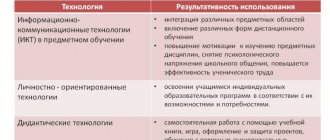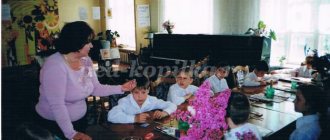For research work, many students, and teachers - for organizing project activities in the classroom, need to find interesting topics for English language projects , which in addition will be relevant and interesting for conducting research.
In this section, we invite schoolchildren and teachers to choose interesting topics for English language projects for grades 3, 4, 5, 6, 7, 8, 9, 10, 11, both for conducting individual and group research and writing creative project work .
- Project topics in English 3rd grade
- Project topics in English 4th grade
- Project topics in English 5th grade
- Project topics in English 6th grade
In high school, students can try using English in a project by selecting the appropriate topics below and having sufficient English language skills to do so.
The list offers new and interesting topics for research creative projects in English for students of grades 3, 4, 5, 6, 7, 8, 9, 10, 11 about history and traditions, education, literature and language, the press, music and culture Great Britain, as well as about folk art, fairy tales, legends and the most amazing capital of London.
This page with a list of project topics is quite popular among schoolchildren and English teachers, since the teacher does not need to search the Internet or come up with topics; it is enough to simply direct students to this page and they will independently select an interesting topic for themselves at home.
- Project topics in English 7th grade
- Project topics in English 8th grade
- Project topics in English 9th grade
- Project topics in English 10th grade
- Project topics in English 11th grade
For ease of selection, we have divided the available topics for creative projects in English into classes, as well as into topics with wording in English and Russian.
In the list below you can find topics for English language projects about the history of English tea drinking, fashion and costume, native British surnames and names, and folk holidays. Topics about the peculiarities of English slang in Australia, Canada and the USA, as well as attractions in the UK are discussed.
In primary and secondary schools, children should choose project topics in Russian, as their English language skills are not yet sufficient for use in an individual research project.
Table.
Sequence of work on the project PDF / 93.88 Kb
- Federal state educational standard for primary general education. M.: Education, 2010. 32 p.
- Pautova I. V. Project activity of students as one of the methods for increasing motivation for learning English // Materials of the All-Russian Scientific and Practical Conference “Science and Society”. 2017. No. 2. URL:
- Plotnikova N. N. Project method in teaching English in primary school: activity aspect // Ped.Rev.. 2020. No. 2 (8). URL:
- Pozdeeva S.I., Kuznetsova T.V. The position of the teacher in the organization of project activities of junior schoolchildren // Vestn. Tomsk State ped. University (TSPU Bulletin). 2010. Issue. 2 (92). pp. 65-69.
- Sovetova T.A. Project activities as a means of implementing the requirements of the Federal State Educational Standard in English lessons and during extracurricular hours. URL:
Goals and objectives of the project in teaching a foreign language
The project method is understood as a learning system in which a teenager acquires knowledge and skills in the process of independent planning and implementation of gradually more complex practical tasks - projects.
Brief historical background
Project from lat. “projektus” literally means “thrown forward.” The French word “projet” translates as “an intention that will be carried out in the future.” The project method emerged at the beginning of the last century. Its founders are considered to be American scientists Dewey and Kilpatrick. They proposed building learning on an active basis, through the student’s practical activities, focusing on his personal interest and the practical relevance of the acquired knowledge in later life.
Today, the project method is successfully developing and becoming increasingly popular due to the rational combination of theoretical knowledge and its practical application to solve specific problems. “I know why I need everything that I learn. I know where and how I can apply it” - this is the main thesis of the modern understanding of the project method.
Project technology is combined with any textbook (UMK) and other educational tools.
Goals and objectives of the project in teaching a foreign language
The main purpose of using the project method in teaching a foreign language is to enable students to master communicative competence, i.e., practical mastery of a foreign language.
The concept of communicative competence includes:
- speech competence - creating the opportunity to demonstrate high-level communication skills in all types of speech activity: listening, speaking, writing, reading, translating within a certain topic; linguistic competence – the student’s mastery of vocabulary on a topic as a necessary basis for developing speech skills; sociocultural competence - acquiring knowledge about the culture of the countries of the language being studied. methodological competence - manifested in the ability to independently work with reference literature, independently acquire the necessary information in various fields of knowledge.
In addition, project-based learning contributes to:
- increasing students' personal confidence; develops “team spirit”, develops communication skills and the ability to collaborate; provides a mechanism for critical thinking, the ability to look for ways to solve a problem; develops students' research skills.
Project typology
A lesson implemented using the project method can be either a lesson in mastering new material or a lesson in consolidating and practicing skills in solving educational problems. The choice of method of scientific knowledge to be used in educational research depends on the specific content of the lesson.
There are different classifications of projects. Thus, he offers five main criteria by which types of projects are distinguished:
1. According to the dominant method or type of activity in the project:
- research, creative, role-playing, informational, practice-oriented (applied).
2. Based on the subject content area:
- monoprojects, interdisciplinary projects.
3. By the nature of contacts:
- domestic or regional, international.
4. By the number of project participants:
- individual, pair, group.
5. By project duration:
- short-term, medium-term, long-term.
6. Based on the results:
- report, album, collection, catalog, almanac; layout, diagram, plan map; video film; exhibition; and etc.
Simon Haynes identifies the following types of projects:
- communication projects or research projects (Information and Research projects). interview projects (Survey projects). Production projects. projects-role-playing games and dramatic performances (Performance and Organizationalprojects).
The following requirements are imposed on the organization of projects:
- the project must be included in the process of teaching and educating students; students must discuss real problems and set current tasks, student activities must be expedient; Students’ work should be meaningful and active; students must be able to clearly formulate their thoughts in writing, analyze new information, and participate in the creation of new ideas; the final type of project (presented in any form) must have an explanatory note, i.e., a theoretical part with a title page indicating the name of the project, author, class, educational institution, supervisor and other necessary information.
Stages of work on the project:
- goal setting; identification of problems, contradictions, formulation of tasks; discussion of possible research options, choice of methods; self-education with the help of a teacher; thinking through the course of activities, distributing responsibilities; research: solving individual problems, layout; generalization of results, conclusions; analysis of successes and mistakes, correction.
A special feature of the project implementation system is the joint creative work of the teacher and the student.
The role of the teacher in project activities
Design in school is impossible without the organizational and cultural position of the teacher. In practice, this leads to a change in the teacher's position. From a carrier of ready-made knowledge, he turns into an organizer of the cognitive activity of his students.
The teacher’s creative, non-standard approach to conducting lessons leads to increased motivation and is focused on students’ independent activities. The role of the teacher is to provide constant advisory assistance.
Project activities allow the teacher to take a more individual approach to the child.
The psychological climate in the classroom also changes. From an authoritative source of information, the teacher becomes an accomplice in the research and creative process, a mentor, a consultant, and an organizer of students’ independent activities. And this is true cooperation.
While working on a project, the teacher:
- helps students find the right sources of information; itself is the source; coordinates the entire process; encourages students; Provides continuous feedback to ensure student success on the project.
The role of the student in project activities
Project activity of students is one of the most important components of the educational process. During the implementation of project tasks, the student becomes involved in an active cognitive creative process based on the methodology of cooperation. He is immersed in the process of completing a creative task, and with it the process of acquiring new and consolidating old knowledge on the subject within which the project is being carried out.
In addition, the student, together with the teacher, completes his own project, solving some practical, research problem. By thus getting involved in real activities, he acquires new knowledge.
Specifics of the project method in teaching a foreign language
The specifics of using project methodology in foreign language lessons arise from the specifics of the subject itself and from the goals and objectives facing the teacher. As you know, the development of the language of a people is greatly influenced by its culture. Therefore, when choosing topics for project activities, school teachers give preference to those topics that contain cultural and historical material about the country of the language being studied that is interesting and valuable for students.
During the implementation of projects, schoolchildren develop the following skills:
- general educational: working with a textbook, with a dictionary, reference books, drawing up a plan for a report, message, speech on a topic, etc.; special: the ability to shorten a text and convey it orally, select thematic vocabulary, use a bilingual dictionary, make short notes on a problem, compose messages, etc.; actual communication skills by type of speech activity, including speech and non-speech behavior.
How can you use the project method in English lessons?
It is important to identify appropriate course topics or sections that will be included in “design”. It should be noted that projects in grades 5-6 are mostly short-term and somewhat simplified in design, but this does not detract from their importance, but only indicates compliance with the age characteristics of students of this age.
It is well known that by the end of the 7th and the beginning of the 8th grade, students’ interest in a foreign language drops sharply. Teachers say that at this age children do not want to study. Scientists, having studied this problem, found the following: 60% of students by the 8th grade retain the desire to learn, but lose interest in the subject.
The experience of using the project method confirms the conclusions of scientists. It is believed that it is a good incentive to increase interest in a foreign language at this age. Projects become somewhat more complex in form and content, a scientific approach to design is practiced, and, accordingly, the time for their preparation increases - they become medium-term.
Get full text
For their work, students receive several grades at once: for design, for content, for defense; special nominations can also be established: “originality”, “scientificness”, “relevance”, etc. This stimulates interest and motivates independent research activities.
Advantages of the project method over traditional methods of teaching a foreign language
In the traditional system, the emphasis is on the assimilation of ready-made knowledge, and learning itself occurs through the use of memory. Projects method:
- develops the student’s intelligence, his ability to plan and track the sequence of actions performed, assimilate knowledge and apply it in practical activities; develops creativity and independence; it is focused on independent activity of students, which presupposes mastery of certain skills: analysis, synthesis, thought experimentation, forecasting; it is creative in its very essence, because it involves a set of research, search, problem methods; when working on a project, the focus is on thought, and language acts in its direct function - the formation and formulation of these thoughts; to a greater extent, compared to standard teaching methods, it introduces schoolchildren to regional studies topics and includes students in an active dialogue of cultures; allows you to teach children the ability to gain knowledge through their activities.
Using the project method it is possible to teach:
- identify and formulate problems; analyze them; find ways to solve them; work with information; find the necessary source, for example, data in reference books or in the media; apply the information received to solve assigned problems.
Conclusion
Thus, the use of project activities in teaching in modern schools is becoming increasingly relevant. And it is no coincidence, because with the help of the project it is possible to implement all the educational, educational and developmental tasks facing the teacher.
The project method allows you to integrate different types of activities, making the learning process more fun, more interesting and therefore more effective.
The use of the project method in teaching foreign languages contributes to the formation of regional studies competence among schoolchildren and the development of their communicative abilities.
The project method gives the teacher the opportunity to take a non-standard approach to classroom and extracurricular activities. It actively influences the intellectual, emotional and value spheres of children.





